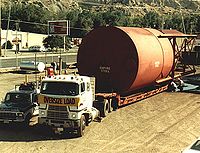Difference between revisions of "Bulk Hoppers"
(Created page with "Category:Silos, Hoppers{{Knoppen}} <noinclude><!------------------------------------------------ * READ THIS FIRST * Only edit this page if you can improve the content. * Im...") |
PurplePen19 (talk | contribs) |
||
| Line 7: | Line 7: | ||
* Please start editing this page after the /noinclude | * Please start editing this page after the /noinclude | ||
* -------------------------------------------------></noinclude> | * -------------------------------------------------></noinclude> | ||
[[File:Bulk hoppers_1.jpg|thumb|200px|right|Bulk hoppers]] | |||
'''Bulk hoppers''' are for the temporary storage of fluid, granular and powder materials. All our hoppers are available in a full range of sizes on an individual basis or integrated into a turn-key, plant wide processing system. Bulk hoppers are large containers for the temporary storage of liquids, granular materials and many other related ingredients. They store these materials for batch and continuous process applications in bulk processing plants. Hoppers are designed so that stored material can be dumped with ease. They are made out of aluminum or steel for heavy-duty use, and plastic for light duty applications. | |||
==CommonTypes== | |||
Hoppers are used for the temporary storage of materials. They are designed so that stored material can be dumped easily and delivered to the processing equipment. There are several different types of hoppers including dumpers and tippers. Other examples include bottom hoppers, live hoppers, cropper hoppers, cullet hoppers, and sludge hoppers; dump boxes, chip boxes, trash boxes, and scrap boxes; and various types of refuse equipment. Bottom hoppers are designed so that stored materials can be dumped from the bottom of the hopper. Dumpers and self-dumping hoppers are included in this category. Live hoppers or live-bottom hoppers use hydraulically or mechanically actuated augers or screws to help discharge viscous materials. Some hoppers have a base that allows them to be lifted by forklift for dumping. Others have a positive locking-latch mechanism to prevent accidental dumping. Tilt hoppers, dewatering boxes, and rotating or rotator boxes may also provide special features. | |||
==Hopper Specifications== | |||
Hoppers can come in a variety of styles with some specialized features for those unique situations. Hoppers can be designed for heavy duty operation. They can be insulated, resistant to moisture, temperature controlled with special mounting methods. Other hopper designs include wheels or rollers for added portability. Other important hopper specifications include: | |||
===Volume Capacity=== | |||
The volume of material a hopper is supposed to hold | |||
===Weight Capacity=== | |||
The weight of material that a hopper can contain | |||
===Depth or Length, Height, Width or Diameter=== | |||
for instance, the distance from the front opening to the back of the hopper. | |||
===Material of Construction=== | |||
while most hoppers are made of plastic or metal, i.e., polyethylene, polypropylene or stainless steel and aluminum. | |||
==Hopper Applications== | |||
Hoppers differ in terms of applications and features. Some are made with the material handling applications in mind. Others are suitable for processing, recycling or handling hazardous materials. | |||
Latest revision as of 20:30, 28 September 2012
Bulk hoppers are for the temporary storage of fluid, granular and powder materials. All our hoppers are available in a full range of sizes on an individual basis or integrated into a turn-key, plant wide processing system. Bulk hoppers are large containers for the temporary storage of liquids, granular materials and many other related ingredients. They store these materials for batch and continuous process applications in bulk processing plants. Hoppers are designed so that stored material can be dumped with ease. They are made out of aluminum or steel for heavy-duty use, and plastic for light duty applications.
CommonTypes
Hoppers are used for the temporary storage of materials. They are designed so that stored material can be dumped easily and delivered to the processing equipment. There are several different types of hoppers including dumpers and tippers. Other examples include bottom hoppers, live hoppers, cropper hoppers, cullet hoppers, and sludge hoppers; dump boxes, chip boxes, trash boxes, and scrap boxes; and various types of refuse equipment. Bottom hoppers are designed so that stored materials can be dumped from the bottom of the hopper. Dumpers and self-dumping hoppers are included in this category. Live hoppers or live-bottom hoppers use hydraulically or mechanically actuated augers or screws to help discharge viscous materials. Some hoppers have a base that allows them to be lifted by forklift for dumping. Others have a positive locking-latch mechanism to prevent accidental dumping. Tilt hoppers, dewatering boxes, and rotating or rotator boxes may also provide special features.
Hopper Specifications
Hoppers can come in a variety of styles with some specialized features for those unique situations. Hoppers can be designed for heavy duty operation. They can be insulated, resistant to moisture, temperature controlled with special mounting methods. Other hopper designs include wheels or rollers for added portability. Other important hopper specifications include:
Volume Capacity
The volume of material a hopper is supposed to hold
Weight Capacity
The weight of material that a hopper can contain
Depth or Length, Height, Width or Diameter
for instance, the distance from the front opening to the back of the hopper.
Material of Construction
while most hoppers are made of plastic or metal, i.e., polyethylene, polypropylene or stainless steel and aluminum.
Hopper Applications
Hoppers differ in terms of applications and features. Some are made with the material handling applications in mind. Others are suitable for processing, recycling or handling hazardous materials.
